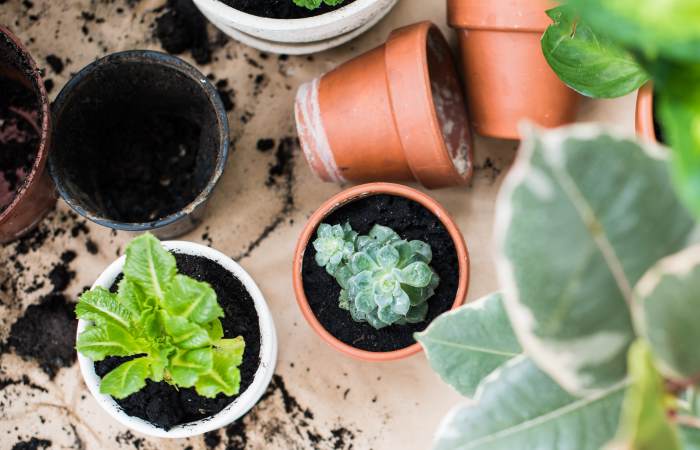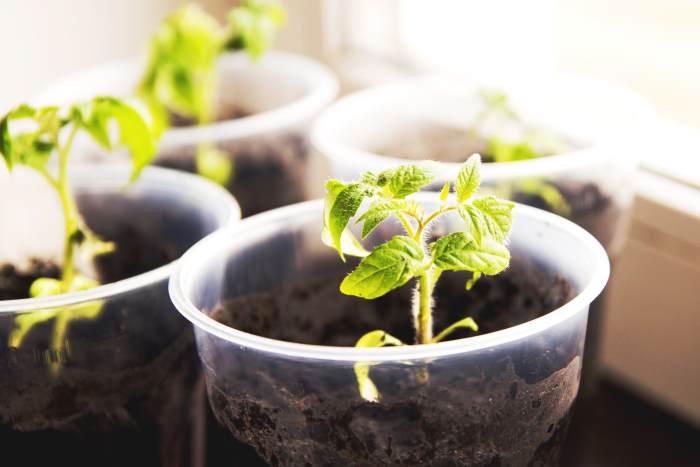Every gardener sometimes fills pots with whatever garden soil they have on hand.
I’m as guilty as the next person, but the real question is, can you use garden soil for potted plants and still achieve the best results?

To find the answer, I did some research. I put all the information right here, starting with why potted plants need different soil and treatment than in-ground plantings.
So come along to find out what you should and should not do when it comes to garden soil and potting soil for potted plants and traditional gardens.
Can I Use Garden Soil In Pots?
You can absolutely use garden soil in pots, but don’t expect the plants inside to fair as well as if they were in proper potting soil.
Why?

First off, garden soil can be very dense, which means it will absorb and hold a lot of moisture.
Not only will the weight alone make the pot challenging to lift and move, but the excessive moisture inside the pot can lead to root rot, even if the planter has proper drain holes.
The next issue using garden soil for potted plants is the fungi or pests that the ground harbors in its natural ecosystem.
While in the ground, these issues may not affect your garden as much as it could when condensed inside a container where the only escape is through that expensive plant you just potted.
There is no reason to contend with wayward weeds filling your pot, mold, or fungi taking over, soggy roots, or hungry insects chewing up the leaves when you can avoid it all by using a clean, lightweight, well-draining potting soil mix.
Lastly, garden soil may not provide the level of nutrients you will find in a fresh potting soil bag that includes a dose of compost in the mixture.
Some manufacturers also add in a slow-release fertilizer to boost growth even more and can last for several months.
Tips For Using Garden Soil In Pots
If you want to save some money by using garden soil in pots, you must follow these tips to ensure your potted plants will be happy and thrive:
1. Sift And Dry The Soil
The best way to ensure the garden soil you are putting into your pots is as free of pests and weeds as possible is to sift the earth through a mesh screen, which will help you spot and catch weed seeds, roots, insects, and other debris that can wreak havoc down the road.
Once you sift the soil, spread the dirt out in a sunny location for a few days to kill off any fungi or microbes that live in moist conditions.
2. Create A Balanced Blend Of Ingredients
Inspect your garden soil for overall drainage and nutrient content. Is it sandy or full of clay? Did you recently add compost or manure to the area?
Before you fill pots with dirt straight from the garden, mix in a reasonable amount of perlite to keep the contents light and airy. Perlite will encourage the good drainage and oxygen flow the plant’s roots require to develop and spread.
Feed those roots by adding in a bucketful of compost or peat moss. The organic amendment will slowly break down and release nutrients into the soil so that plants can look their best.
3. Create The Right Texture
Think about what type of plants are going into the pot. Will it be a succulent that needs excellent drainage and aeration? Will it be flowers that require lots of moisture to keep blooms abundant and full? Will it be a tomato plant that needs extra nutrients?
Once you have your basic garden soil mix from step one, tailor the blend towards the specific needs of the plants you will pot. Add sand or more perlite if the soil needs higher drainage, or add some slow-release fertilizer granules to up nutrient levels.
More compost will hold more moisture for thirsty plants.
The more you perfect a blend that suits your plants, the better they will perform and create less work for you later on.
Can You Mix Potting Soil With Garden Soil?
Mixing potting soil and garden soil together is okay for some planters, such as raised beds or mounds, where a firmer ground is preferred to hold plant roots securely.
For raised beds, most experts recommend blending one part of potting soil with five parts of garden soil.
Using this same blend inside pots and containers can still create a problem with drainage, aeration, and texture, which will be detrimental for your plants. The container sides hold in (and up!) plants, so the soil itself doesn’t need a lot of structure.
If you need to stretch out your potting soil to fill up several containers and don’t have enough, try to balance the garden soil ratio to potting soil 1:1 or 2:1 for better results.
Can I Use Potting Soil In My Garden?
Yes, you can use potting soil in your garden, as any plot can benefit from adding this type of amendment.
I love to recycle the old dirt from abandoned container planters and empty remnants left in potting soil bags onto my garden at the end of each growing season.
I use a tiller to mix the potting soil deep into the dirt, so it can improve texture and add a bit of organic material that will boost next season’s plantings.
While a good garden soil can benefit from the occasional addition of potting mix, you certainly do not want to fill the entire plot with the soil.
Using mostly potting mix will be too light and porous to provide stability and proper moisture levels that your in-ground plants will need to flourish.
In Summary
Now that you have the complete answer to the question, “Can you use garden soil for potted plants?” you can decide for yourself which methods will work the best for your gardening needs.
Potted plants add beautiful visual interest to homes and gardens, so treat them right, and they will reward you in return with lush and colorful flowers and foliage!










